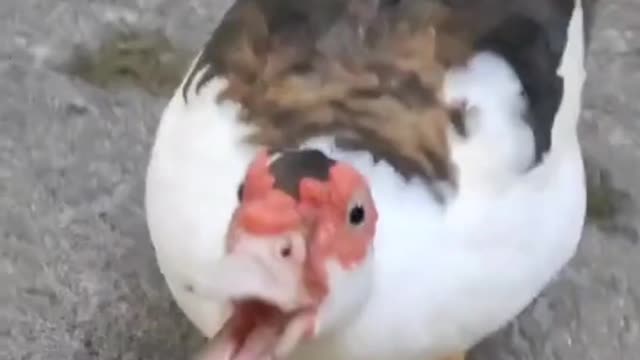Premium Only Content

Angry Muscovy duck.
All Muscovy ducks have long claws on their feet and a wide, flat tail. In the domestic drake (male), length is about 86 cm (34 in) and weight is 4.6–6.8 kg (10–15 lb), while the domestic hen (female) is much smaller, at 64 cm (25 in) in length and 2.7–3.6 kg (6.0–7.9 lb) in weight. Large domesticated males often weigh up to 8 kg (18 lb), and large domesticated females up to 5 kg (11 lb).
The true wild Muscovy duck, from which all domestic Muscovies originated, is blackish, with large white wing patches. Length can range from 66 to 84 cm (26 to 33 in), wingspan from 137 to 152 cm (54 to 60 in) and weight from 1.1 to 4.1 kg (2.4 to 9.0 lb). On the head, the wild male has a short crest on the nape. The bill is black with a speckling of pale pink. A blackish or dark red knob can be seen at the bill base, which is similar in colour to the bare skin of the face. The eyes are yellowish-brown. The legs and webbed feet are blackish. The wild female is similar in plumage, but much smaller, with a feathered face and lacking the prominent knob. The juvenile is duller overall, with little or no white on the upperwing.
Domesticated birds may look similar; most are dark brown or black mixed with white, particularly on the head. Other colors, such as lavender or all-white, are also seen. Both sexes have a nude black-and-red or all-red face; the drake also has pronounced caruncles at the base of the bill and a low erectile crest of feathers.[8] C. moschata ducklings are mostly yellow with buff-brown markings on the tail and wings. For a while after hatching, juveniles lack the distinctive wattles associated with adult individuals, and resemble the offspring of various other ducks, such as mallards. Some domesticated ducklings have a dark head and blue eyes, others a light brown crown and dark markings on their nape. They are agile and speedy precocial birds.
The drake has a low breathy call, and the hen a quiet trilling coo.
The karyotype of the Muscovy duck is 2n=80, consisting of three pairs of macrochromosomes, 36 pairs of microchromosomes, and a pair of sex chromosomes. The two largest macrochromosome pairs are submetacentric, while all other chromosomes are acrocentric or probably telocentric for the smallest microchromosomes. The submetacentric chromosomes and the Z (female) chromosome show rather little constitutive heterochromatin (C bands), while the W chromosomes are at least two-thirds heterochromatin.
Male Muscovy ducks have helical penises that become erect to 19 cm (7 in) in 0.3 s. Females have vaginas that coil in the opposite direction that appear to have evolved to limit forced copulation by males.
-
 DVR
DVR
Man in America
7 hours agoCommunists VS Zionists & the Collapse of the American Empire w/ Michael Yon
41.2K7 -
 LIVE
LIVE
Akademiks
1 hour agoSheck Wes exposes Fake Industry. Future Not supportin his mans? D4VD had help w disposing his ex?
1,340 watching -
 LIVE
LIVE
SpartakusLIVE
5 hours agoTeam BUNGULATORS || From HUGE WZ DUBS to TOXIC ARC BETRAYALS
1,104 watching -
 LIVE
LIVE
BlackDiamondGunsandGear
1 hour agoAre You that guy? / After Hours Armory
145 watching -
 LIVE
LIVE
Camhigby
2 hours agoLIVE - Riot Watch Portland, DC, NC
164 watching -
 2:54:58
2:54:58
CAMELOT331
4 hours agoYouTube Just Told Me I OWE THOUSANDS $ TO THEM... update
12.6K -
 LIVE
LIVE
Tundra Tactical
11 hours ago $0.60 earned🛑LIVE AT 9PM CST!! Your Government Hates Your Guns : DOJ Holds Firm On National FIREARMS ACT
110 watching -
 LIVE
LIVE
DLDAfterDark
2 hours ago $0.59 earnedAre YOU The Guy That Ruins Thanksgiving?? - God Guns & Gear
187 watching -
 2:58:31
2:58:31
NewsTreason
3 hours agoDECLAS w/ Rambo & Dave: Nuremberg 2.0 | MTG Exits Stage Left | Mamdani Psyop Confirmed, 8pm EST
53.4K53 -
 LIVE
LIVE
meleegames
3 hours agoSONG REQUESTS CLOSED - Melee Music - Beat Hazard 3 - Devil Inside
98 watching